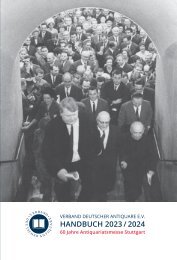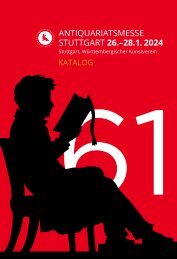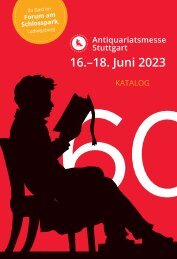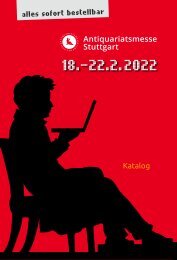Antiquariatsmesse Stuttgart 2021 - Katalog
Katalog zur Antiquariatsmesse Stuttgart 2021: Die Antiquariatsmesse Stuttgart als größtes Schaufenster für wertvolle Objekte des Antiquariats- und Graphikhandels in Deutschland findet in diesem Jahr in ungewohnter Form statt. Da eine Präsenzmesse nicht stattfinden kann, haben sich 76 Kollegen aus Deutschland, Großbritannien, Österreich, Frankreich, der Schweiz, den Niederlanden, den Vereinigten Staaten und aus Australien zusammengefunden, um einen Katalog für die Messe zu erstellen und gleichzeitig ein Angebot für eine virtuelle Messe zusammengetragen. Der Katalog wird am 7. Januar 2021 an interessierte Kunden verschickt, die virtuelle Messe öffnet ihre „digitalen Pforten“ am 29. Januar 2021 um 12.00 Uhr unter www.antiquariatsmesse-stuttgart.de
Katalog zur Antiquariatsmesse Stuttgart 2021: Die Antiquariatsmesse Stuttgart als größtes Schaufenster für wertvolle Objekte des Antiquariats- und Graphikhandels in Deutschland findet in diesem Jahr in ungewohnter Form statt. Da eine Präsenzmesse nicht stattfinden kann, haben sich 76 Kollegen aus Deutschland, Großbritannien, Österreich, Frankreich, der Schweiz, den Niederlanden, den Vereinigten Staaten und aus Australien zusammengefunden, um einen Katalog für die Messe zu erstellen und gleichzeitig ein Angebot für eine virtuelle Messe zusammengetragen.
Der Katalog wird am 7. Januar 2021 an interessierte Kunden verschickt, die virtuelle Messe öffnet ihre „digitalen Pforten“ am 29. Januar 2021 um 12.00 Uhr unter www.antiquariatsmesse-stuttgart.de
Erfolgreiche ePaper selbst erstellen
Machen Sie aus Ihren PDF Publikationen ein blätterbares Flipbook mit unserer einzigartigen Google optimierten e-Paper Software.
One of the finest works on quadrupeds
Ridinger, Johann Elias (1698–1767). Das in seiner
großen Mannigfaltigkeit und in seinen schönen
Farben nach Original-Zeichnungen geschilderte
Thier-Reich … Représentations des animaux selon
leur grande variété et leurs belles couleurs … Augsburg,
Martin Elias Ridinger & Johann Jacob Ridinger,
1768. Two volumes bound together, large folio
(433 × 281 mm); the German text set in fraktur type
and the French in roman with italic headings; the 127
plates coloured by an early hand; near-contemporary
half calf, spine panelled in gilt, gilt morocco
spine label, with a lion device in the top panel and
a small vignette (a mother holding a child, flanked
by a pelican and stag, with 2 birds in the air) in the
bottom panel, the others with a single decoration
(incorporating a shell and two asterisks); sprinkledpaper
sides and marbled endpapers. Full collation
available. € 36 000,–
Rare complete first edition of Ridinger’s great series of
quadrupeds, in the original German with French translation.
This is a classic of zoological illustration, its 127
large and beautifully coloured plates showing wild and
domestic quadrupeds, with a few of the plates depicting
two or more animals, sometimes from different species.
The south German painter, engraver, draughtsman and
publisher Johann Elias Ridinger (1698–1767), born
in Ulm, was educated and worked in Augsburg. His
beautiful and by turns charming, grotesque or amusing
animal plates in the present series are finely engraved
and intended for colouring. The plates show the animals
in characteristic poses, sometimes in motion, in (mostly
natural) landscapes. A few show animals in captivity
or otherwise reveal interactions between humans and
animals.
Among all Ridinger’s works the plates of the present
series are the most sought-after and are considered his
finest work. Ridinger had set up his own art publishing
house in 1723 and later brought his sons Martin Elias
(1730–1780) and Johann Jakob (1736–1784) into the
business; Martin drew and engraved some of the plates
in the present book. Ridinger himself died in 1767 with
the book still unfinished, but his sons continued the
firm, completed the book, signed its texts and published
it themselves. A second edition appeared at Augsburg in
1786 under the title “Naturhistorisches Original Thierwerk”,
with smaller uncoloured plates and an unreliable
text. Reprints of the series continued to appear well into
the 19th century and served as models for animal images
in wall decorations, porcelain and ceramics.
Of the major bibliographers, the Ridinger authority
Thienemann (1856) described the book as virtually
impossible to find (“vollständig wohl nirgends mehr zu
finden”) and never managed to see three of the plates
(I/15 and II/18 & 32), while Schwerdt (1928) knew only
two complete copies: his own and that of Baron Rudolf
Ritter von Gutmann (1880–1966) described by Schwarz
(1910), with the 18th-century bookplate of Henricus Le
Couvreur. There appears to be a complete copy at the
Austrian National Library in Vienna. The title of plate
44 in vol. 2 agrees with Schwerdt (Tamandua Phatagin),
not with Thienemann (Myrmecophaga; omnium maxima.
Phatagin …).
Full details see 4505145 at hordern.com
122






